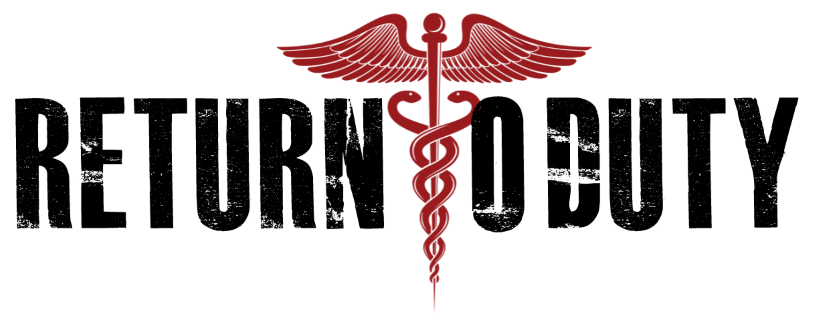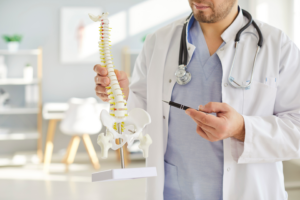Dr. George L. Caldwell, Jr., MD
Florida Spine Care
The shoulder is a complex joint exposed to a great deal of stress during athletic activities. It is a shallow “ball and socket” joint and this design allows a great range of motion in all planes. The tendons responsible for this function are called the rotator cuff.
Basically, four muscle/tendon groups combine to form the rotator cuff complex. These are the supraspinatus, infraspinatus, subscapularis and teres minor. These muscles form tendons that attach to the bone (humerus). The tendons converge upon the attachment and form a “hood,” or “cuff,” of tissue. Hence the name “Rotator Cuff.” Their coordinated function can be quite complex, but suffice it to say that they function to center the ball (humerus) into the shallow joint during movement. In some respects, the deltoid provides the power and the rotator cuff provides the coordination of action for the shoulder movement. (see Figure 1).

Figure 1. Normal anatomy of the rotator cuff tendons. Arthroscope is the instrument to view the shoulder at surgery.
The arm bone, the humerus, can then move in a wide arc to move the hand into position for fine work or provide power and speed for athletic maneuvers. The ability to accelerate a ball over 100 mph or push a 300 pound opponent backwards is quite remarkable.
However, injury and dysfunction can occur with the rotator cuff. Sometimes it is over a period of time with rubbing of the tendons, called impingement (see related article on our website entitled: “Shoulder Pain & Impingement in Pickleball”). Other times an acute trauma may contribute to injury. There is a broad spectrum of wear and injury that must be taken into account by a qualified shoulder specialist to properly assess the situation. The first part of this is a history of the problem from the patient including intensity of pain/weakness, duration, inciting factors, and prior treatments. This is followed by a thorough exam. Quite commonly, shoulder pathology can overlap with neck pathology and this would need to be sorted out. The x-rays provide important information about the bony anatomy of the shoulder and are an integral part of an evaluation.
From there, the physician may recommend a conservative course of treatment that may center on therapeutic exercises or even an injection. If this fails, other options exist. Injections can be considered, but we do so with caution. Injection without therapeutic strengthening will not address the underlying pathology. Some types of injections may accelerate tissue breakdown. As we have previously expressed, “Biologic Agents” have been used for injections, but valid scientific evidence supporting PRP or “stem cell” injections is currently lacking. There is no significant evidence that injections can cause healing of torn tendons.
After making the assessment, the physician may opt to order an MRI. The MRI is a test that permits imaging of the tendons and other tissues including cartilage, biceps and labrum. It is very natural for an aging shoulder to have multiple findings on an MRI, but it is up to the orthopedic specialist to determine which are typical/expected age related changes and which are important pathologic injuries. Unbeknownst to most people, MRIs scans can vary greatly in quality based on a number of factors. We rely on scan machines run by dependable radiologists with expertise in musculoskeletal radiology. We personally review all MRI images ourselves relying on advanced expertise and knowledge of the patient’s history and exam findings.
Tears are often categorized based on their thickness, size, muscle atrophy. Partial thickness tears of the rotator cuff may respond well to physical therapy ( see “Shoulder Pain & Impingement in Pickleball”). However, some tears may be best treated with surgery. Full thickness tears are those that have formed a through-and-through hole in the cuff tendon making it detached from the humerus bone. . These tendons will not heal and repair the hole themselves. The tear may be stable in size or may expand over time. Many factors go into a decision to proceed with surgery to repair a rotator cuff tendon. These include: age, activity level, size of tear, atrophy, and concomitant pathology of the shoulder. Each may affect the decision to operate as well as the outcomes of treatment.
In our practice, we perform repairs arthroscopically. This entails using small instruments (arthroscope) to view and repair the damage. The arthroscope is a small lens with a fiber optic light source attached to a camera that allows the surgeon to visualize and work through with very small incisions. (figure 2)

Figure 2. Tear of the Rotator Cuff tendon.
A skilled arthroscopic surgeon can perform almost all of their shoulder procedures this way, without having to do an “open” shoulder procedure with larger incisions and dissection. Arthroscopic surgery has many advantages including excellent results with minimal scarring and pain when compared to large, open procedures. Our arthroscopic techniques have evolved significantly over the last decade. While it may require more skill and effort than an open procedure, we are convinced that the benefits are superior.
If surgery is indicated, it is performed on an outpatient basis.. At surgery, the patient is under anesthesia and asleep. The surgeon begins by placing the arthroscopic camera system, the “Scope”, into the joint. First step is to work around all of the structures to determine the damage to the inside of the joint and begin cleaning up damaged tissue. Next, the scope is moved to the subacromial space, which is the space on top, or above, the rotator cuff tendons. The tear size is delineated and tissue is prepared for repair (Figure 3).

Figure 3. Cuff tendon tear as seen at arthroscopic surgery
In a repair, we connect the tendon back to the humerus bone. This is done by using sutures to secure the cuff tendon to the prepared bone location and compressing/securing it with sutures to allow it to heal back to its origin. These sutures are placed into the bone using an absorbable “anchor”. This is a threaded insert into the bone (non-metallic), that will absorb later over time. It acts as an attachment post for the sutures in the bone (figure 4).

Figure 4. Absorbable suture anchor is placed into the humerus for repair.
The sutures are passed through tendons and then crossed over the top of the tendon in a particular pattern. These will be used to compress the tendon back to the bone (figure 5).

Figure 5. Sutures from the anchor are passed through the tendon for the repair.
The sutures are then secured crossed over the cuff tendon and placed into a second set of anchors. This serves to attach the tendon to the bone.

Figure 6. Final repair of cuff tendon
Over time, biology allows the tendon to heal back to its original insertion on the bone and the job of the sutures is done. Other portions of the procedure may address problems of the biceps, labrum, bone spurs, and cartilage.

Figure 7. Actual arthroscopic image of rotator cuff repair.
At the conclusion of the procedure, we inject anesthetic around the shoulder for pain control. The current opioid crisis has led us to explore alternatives to the traditional nerve block used in shoulder surgery that frequently led to pain rebound flares and frequent use of opioids to overcome this. Specifically, I have developed an injection protocol to anesthetize the major sensory nerves of the shoulder. ( Figure 8). In our study, many patients recover from surgery with no opioids at all. It has been a major step forward for our patients’ recovery.

Figure 8 . Injecting and anesthetizing the specific sensory nerves of the shoulder
Link to article: http://link.springer.com/article/10.1007/s11420-019-09745-4
Patients are discharged from the surgical center when they are stable and comfortable. We then see the patient in the office the next day to go over surgical photos. Patients may begin normal showers one day after surgery and wear regular clothes with the sling. Patients may use their hand while in the sling. The longer part of the recovery is the rehabilitation. The sling is removed after six weeks. Rehabilitation progresses motion, function and strength with a specific protocol tailored to the patient. The patient may return to full sports at six months after surgery. Overall, the successful outcomes from this surgery are quite high for many patients.




